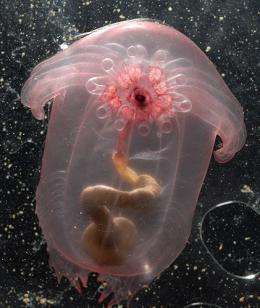Marine Life Census Reveals Previously Unknown Sea Creatures

(��������Org.com) -- UConn marine scientist Ann Bucklin headed one of the projects, surveying zooplankton around the world.
The Census of Marine Life, a decade-long international research program aimed at assessing the diversity of ocean life, has released its first data on tiny sea creatures.
One of the field projects within the Marine Life Census, the Census of Marine Zooplankton, has sampled the ocean’s zooplankton more extensively and systematically than any previous survey. It is directed by Professor Ann Bucklin, head of UConn’s Department of Marine Sciences.
“Invertebrates in general are lovely,” says Bucklin. “They’re just odd, weird, and sometimes scary. You look at them through a microscope and you think, wow, if that thing were big, it would really be something.”
The Census of Marine Life, with 14 different field projects, involves thousands of researchers in more than 80 countries collaborating to describe the ocean’s biodiversity. Before the advent of the Census, about 230,000 ocean species were known to science, but researchers estimate that two to three times this number actually exist. At least 5,300 new species have been discovered thus far in the Census.
Bucklin says, however, that convincing Census leaders that zooplankton - animals that drift on the ocean’s currents - were important to survey took some work. Although the Marine Life Census began in 2000, the Census of Marine Zooplankton didn’t begin until 2004.
“The census started by surveying the ‘charismatic megafauna’,” she says, referring to large marine mammals and fish. “It took four years of going to workshops to convince them that zooplankton are also interesting.”
The Census of Marine Zooplankton aims to survey the diversity, abundance, and distribution of marine holozooplankton - animals that spend their lives drifting on the ocean’s currents. Like other projects within the Marine Life Census, it uses DNA barcoding techniques to identify species with certainty, since many species are cryptic, or look a lot like one another. These techniques involve sequencing a short portion of an organism’s DNA to identify it.
Bucklin’s laboratory at UConn’s Avery Point campus is the project’s major hub for DNA barcoding. In addition to sequencing the DNA of many of the project’s collected species, the lab has now trained more than 20 students and post-doctoral researchers from around the world. The Census of Marine Zooplankton has discovered several hundred new species of zooplankton to date, but Bucklin and her colleagues suspect that once all their data have been analyzed from collections around the globe, the current number of known species will double from 7,000 to 14,000.
This recognition of species is very important, she says. In recent decades, scientific interest in many fields has shifted from studying individual species to a focus on ecological patterns and processes of groups of species, and the science of classifying species has fallen out of fashion.
“Species are a benchmark for understanding big issues like ecosystem health and responses to climate change,” she says. “The Census has been a big win for us: People are again appreciating the value of recognizing species.”
The Marine Life Census will report its final results in an official symposium and press conference on October 4 in London. With the Census drawing to a close, the researchers are now thinking about how to put all their data to good use. Knowing the distribution and abundance of so many of the ocean’s species will help them understand the inter-relationships of species that support Earth’s natural cycles, such as the marine food web and the global cycling of elements.
“The Census asked the question of what species are out there,” Bucklin says. “Now we need to use those data to ask why those species are where they are. We want to know how the oceans change over time.”
More information:
Provided by University of Connecticut
















